When Mozart and his father visited Naples in June 1770 Leopold wrote to his wife: 'On Monday and Tuesday etc. we're going to take a closer look at Vesuvius, Pompeii and Herculaneum – the towns that are currently being excavated - and admire the curiosities that have already been discovered.'[1] Under the guidance of William Hamilton, Leopold and Wolfgang visited not only Vesuvius, but also Caserta, the royal palace of Carlo VII of Naples, designed by Luigi Vanvitelli in 1752 and considered an architectural marvel, and the well-known porcelain factory at Capodimonte, established in 1743. Their sightseeing thus encompassed the old and the new, antiquity, modernity and their confluence: the excavation of ancient ruins was a modern, Enlightenment undertaking.
In the same letter in which Leopold mentions his visit to Vesuvius, he also describes the excursion he and Mozart took to the sites around the Bay of Naples:
- On the 13th - St Anthony's Day - you'd have found us at sea. We took a carriage and drove out to Pozzuoli at 5 in the morning, arriving there before 7 and taking a boat to Baia, where we saw the baths of Nero, the underground grotto of Sybilla Cumana, the Lago d’Averno, Tempio di Venere, Tempio di Diana, il Sepolchro d’Agripinna, the Elysian Fields or Campi Elisi, the Dead Sea where the ferryman was Charon, la Piscina Mirabile and the Cente Camerelle etc., on the return journey many old baths, temples, underground rooms etc., il Monte Nuovo, il Monte Gauro, il Molo di Pozzuoli, the Coliseum, the Solfatara, the Astoni, the Grotto del Cane, the Lago di Agnano etc., but above all the Grotto di Pozzuoli and Virgil’s grave. The Grotto di Pozzuoli is like our Neutor except that it took us 8 minutes to drive through it as it is 344 cannas long.[2]
This letter, like other letters from the family’s tours, tells only a part of the story: what is missing from many of Leopold’s descriptions is any sense of the specific details and impact their experiences had on him, on Wolfgang, or Mozart’s mother and sister. And understandably, since what Leopold wrote was primarily intended to give his correspondents only a brief idea of what they were up to; the letters served as aides-mémoires for fuller descriptions to follow on their return to Salzburg. These fuller descriptions would have included not only an account of details too lengthy to write about in letters, but also engravings and other physical objects given to or purchased by Leopold while on tour (such as the Vesuvius lava he was given by Fréderic Robert Meuricoffre and, what is more, a description of what the experience meant to them and how they responded to the sites and events they witnessed or participated in.
Yet Leopold’s correspondents could also share in advance some of what the adventure must have been like. In a letter written at Verona on 7 January 1770 Leopold mentions ‘Comte Justi, who has a beautiful garden and an art gallery. You may be able to find them in Keyssler’s accounts of his travels.’ And from Rome on 14 April he wrote to his wife and daughter: ‘Pleased though I am that the two of you didn`t come with us on this trip, I`m sorry that you`re not able to see all the towns and cities of Italy, but especially Rome. It`s unnecessary, indeed impossible, to describe it in only a few words. Once again I advise you to read Keyssler’s account in his travels.’ Johann Georg Keyssler’s Neueste Reisen durch Deutschland, Böhmen, Ungarn, die Schweiz, Italien und Lothringen (first published at Hannover, 1740-1741), one of the most highly-regarded travelogues of the mid-eighteenth century, was apparently Leopold’s chief guide to Italy. It not only prepared him and Wolfgang for their travels but also, when they were away from Salzburg, allowed Mozart’s mother and sister to share in the adventure, at least at a distance and until Mozart and his father returned home with their souvenirs, engravings and stories. By the same token, Keyssler opens a window on the Mozarts’ experience of traveling that would otherwise be irretrievable, given the brevity of the letters themselves.

Johann Georg Keyssler, Neueste Reisen (Hannover, 1751), the frontispiece and title page
In order to give a fuller sense of what Leopold and Wolfgang experienced while in Naples, the following is extracted from the English-language edition of Keyssler, Travels through Germany, Bohemia, Hungary, Switzerland, Italy and Lorrain. Giving a True and Just Description of the Present State of those Countries; their Natural, Literary, and Political History; Manners, Laws, Commerce, Manufactures, Paintings, Scultpture, Architecture, Coins, Antiquities, Curiosities of Art and Nature, &c.[3] The extracts describe the sites and places of interest in travelling from Naples around the Bay of Naples, through Pozzuoli and Baiae to the tip of the peninsula at Miseno, and then back towards Naples.
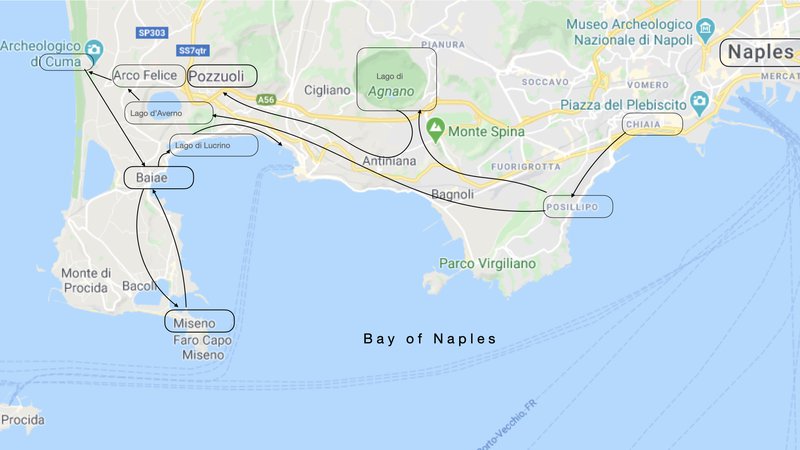
Schematic route of trip described by Keyssler, overlaid on modern map from googlemaps.com
Keyssler describes two routes from Chiaia, on the outskirts of Naples, to Pozzuoli, one inland via Lago di Agnano, and the other along the coast to Lago d'Averno. From Pozzuoli the route goes to Arce Felice and Cuma, then down to Baiae, and on to Miseno. The return towards Naples is via Lago d'Averno and Lago di Lucino. Numerous places of interest are described along the way, including not only sites of archaeological or historical significance, but also many of contemporary interest.
Headings have been inserted into the text below to provide markers. This is an editorial intervention with the aim of assisting readers. Modern spellings of place names are used in the headings, corresponding to those in the map above. These spellings are not always the same as in the English version of Keyssler's book (which is itself inconsistent), but the latter are close enough to the modern spellings to avoid ambiguity. It is clear from Leopold's letter, above, that he took a different route from that described by Keyssler, travelling by boat from Pozzuoli to Baiae, for example. Nevertheless, almost all the locations and sites mentioned in the letter are described by Keyssler, albeit the order of discovery is different. Where it seems appropriate for clarity, the name used by Leopold is included in parentheses in the heading.
To provide further assistance, there follows a linked index of these headings. Many of the places are still accessible, and indeed many remain tourist attractions, so in addition, after each heading, or elsewhere if appropriate, there is a link - [info] - that will take the reader to a page of additional information and modern photographs, drawn primarily from Wikipedia and tourist websites, as indicated in each case; following this information is a link to bring the reader back to the appropriate place in the narrative below. (Note the modern information about these places is collected in the Place entity 'Naples: Bay of Naples - Day Trip locations', where they appear in alphabetical order, and can be browsed independently.)
Links to headings
Chaia to Pozzuoli: inland route via Lago di Agnano
Monte di Posillipo: Ancient mausoleum/Virgil's Tomb
- Posillipo Tunnel (Leopold's 'Grotto di Pozzuoli')
- Lago di Agnano
- Baths of San Germano
- Grotto del Cane
- Astruni (Leopold's 'Astoni')
- Monte Secco/Solfatara
- Pozzuoli
- Pozzuoli Cathedral
- Pozzuoli Harbour (Il Molo de Pozzuoli)
Posillipo to Cuma: coastal route
Hot baths - Academia Ciceroniana
- Monte Gauro/Barbaro
- Monte Nuovo
- Lago d'Averno
- Arco Felice
- Tempio del Gigante
- Cuma
- Sibyl's cave (Grotto of Sybilla Cumana)
Cumae to Baiae
Temple of Diana and Temple of Mercury
- Temple of Venus
- Baiae
- Agripinna's Sepulchre
Baiae to Miseno
Caesar's Palace - Elysian Fields
- Dead Sea/Mare Mortuum
- Miseno
Return to Naples
Piscina Mirabilis - Cento Camerelle
- Baths of Tritoli (Baths of Nero)
- Lago d'Averno
- Lago di Lucrino/Monte di Christo
OF THE ANTIQUITIES AND NATURAL CURIOSITIES NEAR THE CITY OF NAPLES TOWARDS PUZZUOLO, BAIÆ, CUMA, MISENO, &C.
All except one of the images below are from: Filippo Morghen, Gabinetto di tutte le più interessanti vedute degli antichi monumenti esistenti in Pozzuolo, Cuma e Baja e luoghi circonvicini... (Cabinet of all the most interesting views of the ancient monuments existing in Pozzuolo, Cuma and Baja and surrounding places) (Naples, 1803). The exception, also contemporary, is the engraving showing Lago di Agnano, based on the painting by Pietro Fabris.
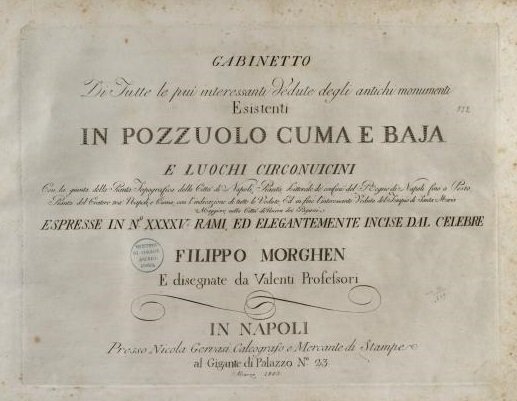
Filippo Morghen Gabinetto Title page
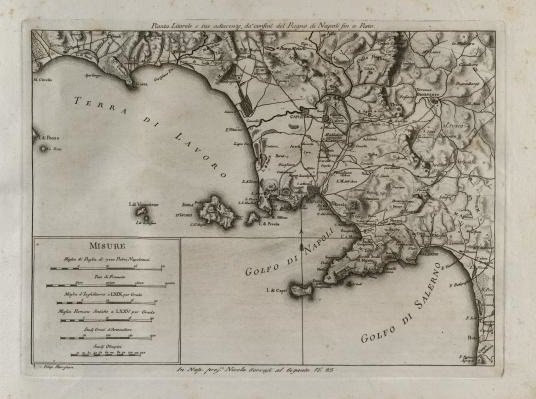
Map: Bay of Naples
Chiaia to Pozzuoli: inland route via Lago di Agnano
Chiaia - Posillipo - Lago di Agnano - Solfatara - Pozzuoli
Monte di Posillipo: Ancient mausoleum/Virgil's Tomb
Monte di Posillipo: Ancient mausoleum/Virgil's Tomb [info]
A Foreigner who is desirous of reaping instruction and advantage from his travels in Italy, should not neglect spending some days in visiting the country about Puzzuolo, Cuma, &c. In going from the suburbs of Chiaja to the Grotto del Monte di Posilipo, &c. on an eminence to the left, in a garden, at present in the possession of Don Paolo Ruffo[4], are to [be] seen the ruins of an ancient mausoleum. It was originally built in the form of a pyramid; but the lower part, which is all that now remains of it, is not unlike a large oven. The way to it is not to be found without a guide; and on the side towards the cave of Pausilypo it is so narrow, and runs along such a high precipice, that it is something dangerous to person subject to dizziness. This ancient ruin generally passes for the monument of the poet Virgil; but without any sufficient grounds for such a conjecture[5]. In the wall within it are ten small niches or cavities, apparently designed for urns. According to Alphonso de Heredia, late bishop of Ariano[6], the marble urn, in which Virgil’s ashes had been deposited, stood here on nine small marble pillars, of which, at present, there is not the least appearance; and what became of such a remarkable piece of antiquity is also a great mystery. . . In going by water from Naples to Puzzuolo, not far from Cape Pausilypo one passes by a dome or cupola hewn out of rock, supposed to be the remains of a temple of Venus, though vulgarly, but for what reason I know not, called la Scuola di Virgilio...
Posillipo Tunnel (Leopold's 'Grotto di Pozzuoli')Posillipo Tunnel (Leopold's 'Grotto di Pozzuoli') [info]
Formerly in going from Naples to Puzzuolo it was necessary to cross mount Pausilypo ... but at present that trouble is spared, a broad subterraneous road being cut through the mountain. This passage is conducted for the most part through large rocks, and sometimes through strata of sand. It is at both ends betwixt ninety and a hundred feet high in order to throw in more light. Towards the middle where the top is lower, two large vent-holes for light and air are made through the roof of this grotto: however, the light is not sufficient, and travelers are extremely incommoded with dust in this subterraneous passage. The bottom of it, which in the time of Don Pedro de Toledo, vice-roy under Charles V[7], was paved with broad stones like the streets of Naples, is cleaned several times a year, and the it is pretty free from dust; but, as it is a road extremely frequented, this convenience is of no long duration. The breadth is betwixt eighteen and twenty feet, so that there is sufficient room for two carriages to avoid each other: and, to prevent any inconveniency on this head, it is usual in the dark places to call out to any person coming the contrary way, to know on which side they intend to keep. When they answer alla Montagne it signifies the Naples side, which, to those coming from the city, is on the right hand; and alla Marina denotes the left-hand side.
The length of this subterraneous passage is about three hundred and forty-four canne, which is something more than half an Italian mile[8]. On the left hand, near the middle of it is an oratory hewn out of the rock, with a lamp continually burning in it. This grotto is by the vulgar supposed to have been made by magic, and that Virgil was the sorcerer who wrought it. The Neapolitan writers, after Strabo, affirm it to be the work of one Cocceius, of whom they can give no further account... The Neapolitan historians agree, that king Alphonso I, of the Aragon family[9], caused this passage to be considerably widened; and Don Pedro de Toledo vice-roy under the emperor Charles V. is known to have given orders for levelling and paving of the ground, as likewise the enlarging of two vent-holes which had been at first bored through by order of Alphonso I. . .
Lago di AgnanoLago di Agnano [info]
At coming out of the grotto of Pausilypo, you turn off on the right hand into a very pleasant road, which running betwixt five vine-yards, leads to the Lago d’Agnano, which is almost a perfect circle about an Italian mile in circumference. At high water in some parts of it is seen a strong ebullition: on approaching near it one is indeed sensible of the motion of the water, which possibly proceeds from the violent ascent of effluvia, which do not, however, convey any heat. The tenches[10] and eels in this lake in winter are of a very good flavor; whereas in summer they are not eatable, which I impute in some measure to the great quantities of flax and hemp which are brought thither from all the neighbouring parts to be mellowed...
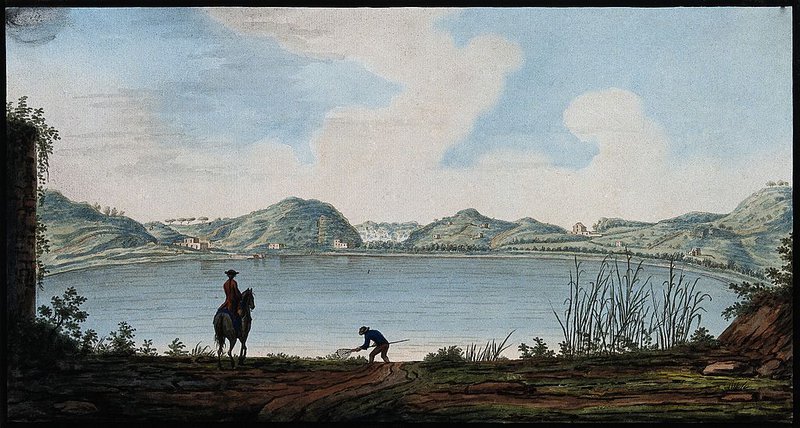
Pietro Fabris, Lago di Agnano
Baths of San GermanoBaths of San Germano
Near this lake stand I Sudatorii di S. Germano, or sudatories of St. Germano[11], which consist of several apartments built with stone, where the heat and sulphureous vapours issuing from the earth soon cause a profuse sweat; in some places the wall is too hot for the hand to bear it, and yet the heat is supportable in the hottest room, especially if you stoop towards the ground: the same observation is made on the baths of Tritoli.[12] The patients are put in rooms of different degrees of heat, according to the nature of their complaint; and in the sudatories of St. Germano they never stay above a quarter of an hour at a time: they are said to be very efficacious in the gout, debilities, inwards hurts, &c.
Grotto del CaneGrotto del Cane [info]
Within a hundred paces of these sudatories is a small natural cavity, known by the name of the Grotta del Cane, or Dog’s Grotto, that animal being generally chosen for the proof of the surprising effect of the vapour in this cavity. It is about twelve feet in length, five broad, and six high, and it stands within twenty paces of the lake d’Agnano. The vapour which rises in it is condensed on the roof and sides into very clear drops; unless, as this phaenomenon is not constant, they rather proceed from the rain water collected on the little eminence over it, and soaking through the pores of the earth. This grotto is left always open, for there is no door nor inclosure to shut it up. In the way to the Lago d’Agnano there is a cottage where lives a man who makes it his business to keep dogs, in order to shew strangers the surprising effects of this grotto, and is generally rewarded with five or six carlini[13]. The dogs, when they find that they are to undergo this experiment, become untractable and use their utmost efforts to make their escape.
The owner of the dog going into this cavern holds its nose forcibly to the ground, when after a minute and a half, or two minutes, the creature falls into violent convulsions, and in about two minutes longer becomes quite motionless, as if he was dead. The man, during the operation, is almost on his knees; but throws his head back as far as possible, that the vapours in their ascent may not affect him. The dog, having lain two or three minutes in all appearance dead, is thrown into a lake hard by, where within half a minute some signs of life are perceived in him. For a minute after he seems to be dizzy, and reels from side to side, when on a sudden he presently recovers and leaps upon his master with the greatest joy and fondness. But if the dog, or any other animal, be left too long in the cave, it dies irrecoverably, so that the immersion in the lake has no manner of effect on it. It is observable that the space during which animals may remain in the cavity without the total loss of life, is not the same in all species, and must not exceed the duration of the convulsions before they become motionless and apparently dead. A viper the first time bears the vapour from six to nine minutes before it becomes motionless; but, after recovering itself in the lake, it seems to have fortified itself with fresh vigour and laid up a provision of air. Accordingly it appears larger and inflated, and will undergo a much longer trial, even sometimes an hour and a quarter before it dies irrecoverably. It is also the same with regard to frogs; and indeed the air-pump experiments shew, that the oftener an animal is rendered motionless by the rarefaction of the air, and afterwards released to the free enjoyment of that element; the longer it will bear the want of a denser air, and as it were become accustomed to that rarefied air which at first was near proving fatal to it in a short time...
Astruni (Leopold's 'Astoni')Astruni (Leopold's 'Astoni') [info]
About half an Italian mile[14] from the Lago d’Agnano, in a circular valley six miles in circumference, is a delightful forest, and three small lakes. This charming spot is called Astruni, and here the vice-roys usually take the diversion of hunting. In the year 1452, king Alphonso d’Aragon entertained the emperor Frederic III, (who came to Naples to receive his bride Eleanora on her landing from Portugal)[15] with a very splendid hunting-match in this valley, on which occasion three thousand persons were feasted, and fountains ran with several sorts of wines. On an eminence near this forest is a tower, which yields a most charming prospect...
Monte Secco/SolfataraMonte Secco/Solfatara [info] (See also Campi Flegrei [info])
Further on towards Puzzuolo, on the right-hand, lies Monte Secco, which is here and there covered with small shrubs, and a kind of broom. The summit of this mountain, which is known to have been once in the form of a cone, is now sunk into an oval cavity, about a thousand feet in the shortest, and twelve hundred and forty-six in the longest diameter. This place Strabo, in his fifth book, calls Forum Vulcani, and it is at present known by the name of Solfatara, or rather Solfarata.
A person who is fond of seeing natural curiosities cannot but meet here with the highest entertainment, as without danger and much trouble he may behold Vesuvio in miniature. Though the Solfatara be upwards of two German miles distant from Vesuvio, it is unquestionable that both these volcano’s have a communication with each other: for it is observed that the smoke, heat, and force of the subterraneous fire is less violent in the Solfatara when Vesuvio rages, and gives a free vent through its mouth to the sulphuerous vapours that have been pent up in it; whereas, on the other hand, the heat, &c. in the former increases, when the latter is at rest. Several fissures, or chasms, that emit smoke, &c. are seen in this place, and their vehemence increases, the more the fissures are widened; so that at last a man cannot approach them on account of the heat. A sword, or any other piece of iron, being held over one of these holes or spiracles, a sweetish kind of condensed steam drops from it; but a sheet of paper fastened to a stick, so as not to be blown away by the air issuing from the aperture and held over it, receives not the least moisture; nor is it damaged by the heat, but becomes very dry and stiff. The stones which lie about these apertures seem to be in continual motion. And upon throwing a handful of small pebbles into these holes they are ejected to the height of about twelve feet, and sometimes thrown obliquely on the sides, as more ponderous masses are from Vesuvio. In some places the sand, by the force of the effluvia, springs up and down near the vent-holes, like the sparkling of Champagne or cyder. . . The steam or vapour issuing from these apertures of the Solfatara is said to be serviceable in a great many disorders. The soil hereabouts is so light and hollow that it is dangerous to use a horse in this excursion...
PozzuoliPozzuoli [info]
Puzzuolo is eight Italian miles distant from Naples, and takes its Latin name Puteoli, either from a sulphureous stench, or from the great number of putei or holes which are made here on account of the Sulphur works, and by digging for sand, which in ancient times was found very serviceable for building, especially under water. This city stands on an acclivity, and the great quantity of beautiful stones and gems cast up by the sea is sufficient proof of its former splendor and magnificence. The greatest part indeed of these stones are of a blue or red cast, with several pieces of verde-antico, porphyry, &c. and seem to have been used in mosaic work; there are frequently found among them agate, cornelian, amethyst, jasper, onyx, beryl, Lapis-lazuli, &c...[16]
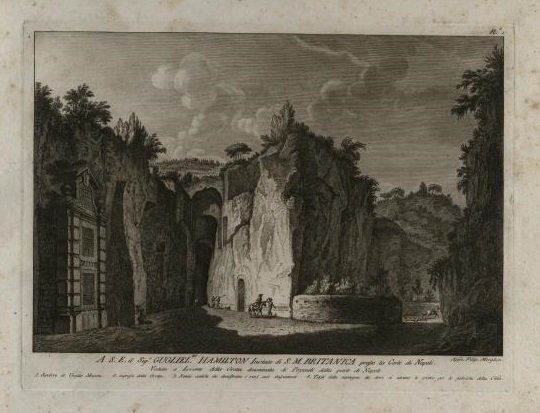
Puteoli di Pozzuoli
Pozzuoli CathedralPozzuoli Cathedral [info]
The cathedral of Puzzuolo is built with large blocks of marble, and was converted from a pagan temple into a Christian church . . . It is now dedicated to St. Proculus and St. Januarius, whose statues of marble stand in the middle of the church . . . At the entrance of the church, on the left-hand, is a beautiful altar of inlaid work, with a very costly tabernacle, in which lapis-lazuli has not been spared. On the high altar the beheading of St. Januarius is extremely well painted. Puzzuolo, antiently Puteoli, values itself as having been honoured with the first Christian community in Italy; St. Paul, in his journey to Rome, having found brethren there.
Pozzuoli Harbour (Il Molo de Pozzuoli)Pozzuoli Harbour (Il Molo de Pozzuoli) [info]
The harbor of Puzzuolo is very commodious, and is formed by fourteen piers, or pilasters, rising above the surface of the water, which were anciently joined together by arches. The nearest pilaster on the Puzzuolo side consists of large blocks of that sort of stone called piperno[17], but faced with brick-work; and the interstices are filled up with a very hard mortar or cement, which is, undoubtedly, mixed up with Puzzuolano, or the Puzzuolo sand. On the sides of these pilasters are vast stones, with holes in them, for fastening ships, &c. The force of the waves is very much broken against these piers; and many judge them better for securing a harbor than a continuous mole, as in the former the accumulation of sand is not to be apprehended, the waves washing it back again through the intervals between the pilasters. From the ruinous arch-work some have been induced to look upon these pilasters as the remains of a bridge; and the common people usually call it il ponte di Caligola, as if it were the ruins of the bridge built by that emperor from Puzzuolo to Bajae...[18]
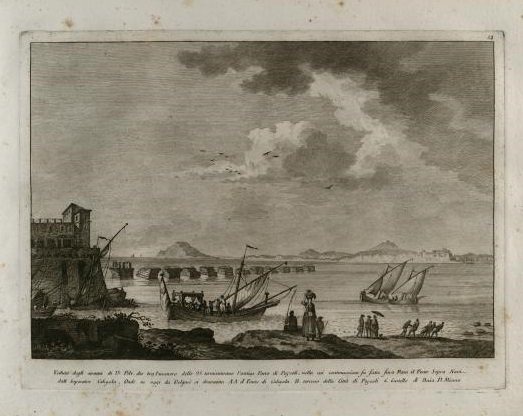
Ponte Caligula
The sea about Puzzzuolo abounds in fish, especially of the testaceous kind. Here is also a fish called Cavallo Marino, which is not quite an inch in length, and is generally dried for keeping[19]. The head of this little fish very much resembles that of a horse: it is often bruised with vinegar and honey, and applied by way of plaister to the part bitten by a mad dog; and the women eat them to procure a good breast of milk, and likewise apply them to the breast as an anodyne[20]. This species of fish is also found on the other side of Italy, along the coast of the Adriatic; but not in such abundance as they are here.
Posillipo to Cuma: coastal route
Hot baths - Academica Ciceroniana - Monte Barbaro - Monte Nuovo - Lago d'Averno - Arco Felice - Cuma
Hot baths - Academia Ciceroniana
Hot baths - Academia Ciceroniana
The road on the right-hand, by the Grotto del Cane and Lago Agnano, is not the nearest way from the grotto of Paulsilypo to Puzzuolo, that which turns off on the left towards the sea, and runs along the coast: besides it is broader and pleasanter, as well as shorter than the other road. The barren mountain of Olivano lies on the right-hand of this road, and it is with a pleasing surprise a traveler sees a country, which was once only the dreary haunt of sea-fowls, &c. so greatly improved with a road extremely commodious for carriages and horses...
There are several hot baths along the coast, impregnated with alum, copper, and iron. On a spot about five hundred paces from Puzzuolo, near the sea, persons laboring under the gout or rheumatism are laid in a hole, dug in the ground for that purpose, according to the size of the patient, and about two feet deep; where the whole body, especially the part affected, is covered with sand which came out of the hole, and, when it is too hot, they cool it by pouring some sea water on it. This method, if often repeated, seldom fails of abating the violence, if not totally expelling the disease...
Just without Puzzuolo are the ruins of an ancient structure, said to be the villa or academia Ciceroniana, where the body of the emperor Adrian was deposited till the senate of Rome built a temple at Puzzuolo for his interment[21]... At present this celebrated academia is converted into a cow-house. Not far from it are some of the ruins of an old structure, which passes for Lentulus’s feat.
Monte Gauro/BarbaroMonte Gauro/Barbaro [info]
Gauri, a mountain in this neighbourhood, and in Juvenal, Sidonius Apollinaris, Galen, and Statius, highly celebrated for its wine, is at present a barren spot, and called il Monte Barbaro; but whether this proceeds from the degeneracy of the soil, or the long possession of the Saracens, is uncertain. However, the Franciscan have a convent upon this hill, which affords a glorious prospect[22]. The vulgar here are possessed with a notion that immense treasures lie buried in this mountain; but guarded by evil spirits, whose favour not a few endeavor to procure by incantations, &c.
Monte NuovoMonte Nuovo [info]
Directly opposite to il Monte Barbaro, towards the west, lies il Monte Nuovo, or the new mountain, which rose instantly in the night between the nineteenth and twentieth of September, 1538, during an earthquake, which caused a terrible devastation in the neighbourhood[23]. The subterraneous fire, after making a wide chasm in this place, eject such a quantity of stones, ashes, sulphur, and sand, as within twenty-four hours formed this mountain; the perpendicular height of which is not less than four hundred rods, and the circumference is three Italian miles. . . No fire, sand, or stone is known to have been ejected since the first formation of the mountain...
Lago d'AvernoLago d'Averno [info]
The way to Cuma lies betwixt Monte Barbaro and Monte Nuovo, the former being on the right, and the latter of the left hand. About half a mile from the Lucrine lake, on the left-hand, is the Lago Averno, which, like the mountain Gauri, is exceedingly altered, but much for the better. According to ancient historians, no fish could live in this lake; and its noxious vapours ascended to such a height, that birds flying over it dropt down dead...[24] This lake is at present stocked with a variety of good fish, and the birds not only fly over it unhurt, but wild ducks and other aquatic fowls are to be seen upon it; and the adjacent vine-yards produce a very good sort of wine...

Lago Averno
Arco FeliceArco Felice [info]
Betwixt Averno and the city of Cuma is to be seen a part of the Via Appia, where two hills are joined by means of a noble arch called Arco Felice, built with large bricks; its height is seventy, and its breadth fifty-five feet; the passage under it is twenty feet four inches.
Tempio del GiganteTempio del Gigante
After passing the Arco Felice, a narrow way leads to the remains of a temple, which, as the deity to whom it was consecrated is not known, is called il Tempio del Gigante. The arched roof of it is divided into small square compartments, like those in the temple of Peace at Rome, and plates of gold or silver, and other ornaments, seem to have been once fixed in them. This temple is thirty-six palmi in length, above thirty in breadth, and about forty in height. The colossus which stands at Naples, not far from the Darsena, called il Gigante di Palazzo, supposed to have been a Jupiter Terminalis, is said to have been dug up near the front of this temple[25].
Not far from this temple, on the left-hand, is an ancient edifice ninety-six palmi in length, and twenty-six in breadth, with an aperture in the roof to admit the light, which, from the many niches in the sides, where probably the urns with the ashes of the dead were set, is looked upon to have been a pagan sculpture.
This country affords several other remains of antiquity worth a traveller’s notice; among which the antique statues, which contribute so much to the grandeur of the yet-unfinished university at Naples, are to be reckoned[26].
CumaCuma [info]
The greatest part of the ancient city of Cuma, with its magnificent temple of Apollo, was situated on a hill which afforded a beautiful and extensive prospect. This city, celebrated in the times of the ancient Romans, is now reduced to a heap of ruins[27].
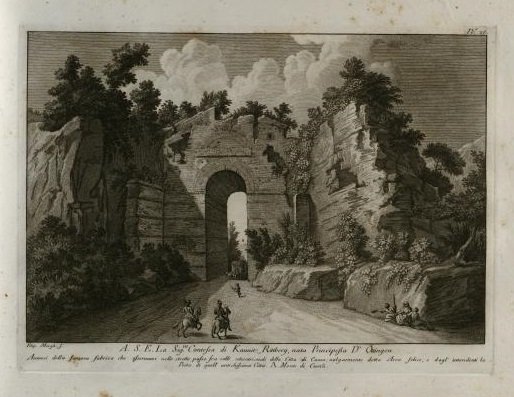
Approach to Cuma (walls and gates)
The country still retains a luxuriant fertility, especially towards Torre di Patria, where it produces abundance of fig-trees of an uncommon size. The name of di Patria applied to this tower, is said to be derived from the second word in the following line, which Scipio Africanus ordered to be put upon his monument:
- Ingrata Patria, ne quidem ossa mea habes...
This place was anciently called Linternum; and, when it was besieged by the Vandals in 455, this tower was built on the spot where stood the great Scipio’s tomb; and the word patria being all that was then legible on the monument, gave name to the new tower.
Near the city of Cuma is a very large reservoir, with a lofty arch over it, in which are several apertures, like wells, for drawing out the water. It is built of free-stone, and at present is quite empty. As far as can be conjectured from the sound caused by stamping with the foot against the bottom, there is another cavity under it.
Sibyl's cave (Grotto of Sybilla Cumana)Sibyl's cave (Grotto of Sybilla Cumana) [info]
On the opposite side, towards the sea-coast, is the entrance of a cave, said formerly to have been the abode of the Cumæn Sibyl[28]. If the antiquarians may be credited, this cave extends three Italian miles in length to the Lago Averno, where it has another entrance: but in several parts the passages have been ruined; and at the entrance near Cuma there is no possibility of advancing in it above two hundred paces. This part of it is cut out of a rock, and of a considerable height and breadth. A few years ago the imperial general Wezel[29] caused an aperture with one-and-fifty steps to be cut in the side of the cave, for the conveniency of coming out of it; but the peasants have since stopped it up.
Cuma to Baiae
Temple of Mercury - Temple of Venus - Baiae
Temple of Diana and Temple of Mercury
Temple of Diana [info] and Temple of Mercury [info]
Betwixt Cuma and Misena . . . a narrow road among rocks, and over a steep eminence where a continual guard is kept, leads to the ruins of Lucius Piso’s warm baths[30]; or according to others (though, I think, not with sufficient grounds), of a temple of Diana; and from thence to the delightful bay of Baiæ. In this bay, which is in the form of a crescent, the ships ride in perfect safety. On the sea-shore, facing Baiæ, is an ancient temple of Mercury[31], which may be looked upon as the Pantheon in miniature; for it is not above twenty-five common paces in diameter. It is quite round, with an aperture in the center of the roof for the admission of light: two persons directly opposite to each other, whispering close to the wall, may converse with each other without being over-heard by the company in the middle. Besides the round aperture at the top, this temple has four windows. The pavement at the entrance lies a foot under water, and most of it is either overflowed, or covered with rubbish; there is also a large crack of fissure in the cupola.
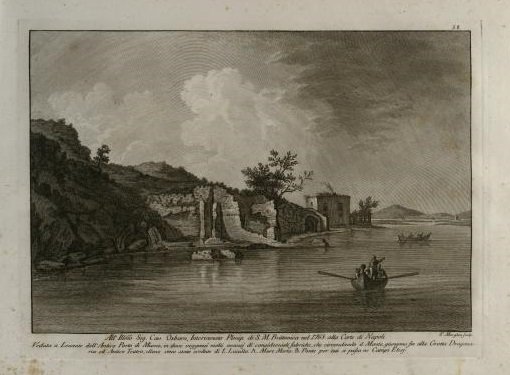
Tempio di Mercurio
Temple of VenusTemple of Venus [info]
Not far from this temple, and nearer Baiæ, is an octagular shell of a temple of Venus, which is seven palmi thick, with eight large windows, and its inward circuit is seventy-three paces.
Behind this temple is a dark apartment hewn in a rock, called la Stanza di Venere, or Venus’s apartment[32], the roof of which is embellished with basso-relievo’s. These pieces represent nothing obscene or immodest, but only mythological stories and emblems, as a man pursuing a woman, a Cupid, several swans, fishes, festoons, &c. The marquis de Cellemare[33] has stript this place of some of its best pieces, and a Centaur has been carried from hence to France; all these statues will be totally disfigured with the smoke of the flambeaux which are necessarily used in such dark recesses. In a side chamber, to which one must creep through a hole, is the figure of a tree formed by a kind of spar; but by some erroneously supposed to be a petrified vegetable. This Stanza di Venere lies betwixt the above-mentioned temples of Venus and Mercury.
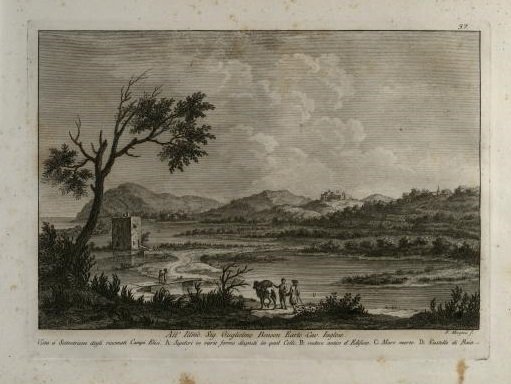
Tempio di Venere
BaiaeBaiae [info]
...As for the city of Baiæ, which stood on this coast, there is not the least remains to be seen of it[34]. The fort lately built here is called Baia, and stands upon a rock; but the air of it is so unwholesome, that the governor takes care every night to lie at Puzzuolo. Sometimes prisoners are brought to the fort of Baia, which is more dreaded than any other prison in Italy.

Baia
After passing a precipice that projects over the sea, you descend again to the shore; where the remains of Hortensius’s villa are to be seen. This celebrated orator Cicero jestingly calls him Triton, because he had accustomed the fishes in his ponds at this villa, to come at his call, and fed them with his own hand[35].
Agripinna's SepulchreAgripinna's Sepulchre [info]
Near Hortensius’s villa is shewn an ancient ruin, said to have been the monument of Agrippina, who was put to death by Nero, her own son. Within it on the left-hand, is an apartment, to which one ascends by a ladder, where are several relievo’s of plaster, representing a sphynx, a griffin, and other imaginary animals. A figure of a woman about two feet high to be seen here, passes for Agrippina herself; and adjoining to this is a smaller apartment, where the antiquarians say that her remains were deposited: but with what truth, or even probability, is not easily determined...
Baiae to Miseno
Elysian Fields - Dead Sea - Miseno
Caesar's Palace - Elysian Fields
Caesar's Palace - Elysian Fields
Betwixt Baiæ and Cape Miseno are likewise several other remains of antiquity; but the explanations of them are mostly grounded upon uncertain conjectures. Amongst other pieces there has been dug up hereabouts the statue of Venus, twice as big as life, holding a globe in one hand, and three golden apples in the other; from whence some antiquarians conclude, that Venus Genetrix must have had a temple in this neighbourhood; and, as Julius Cæsar had a country seat near Baiæ[36], others still farther allege, that he founded and built this temple.
On this coast there is likewise an ancient temple called Boaula, or Boalia, ascribed to Hercules, who, according to the ancient fable, brought safe hither the oxen which he had stolen in Spain... The antiquarians are at a loss where to look for Bauli, or the villa whither Nero conducted his mother, after her coming from Antium. According to Tacitus it must have stood betwixt cape Miseno and the Lago Bajano... That the Elysian-fields extend themselves towards the Dead-Sea, is taken for granted; but, as for the exact situation, some look for it about the district of Baula, where at present stands a mean village; and in the wall, built on both sides of the way, are several cavities, in which probably some urns were once deposited. Others place the Elysian-fields near the Mercato del Sabato, as it is called. Others again are positive that the Elysian-fields must have been in the neighbourhood of Cuma. All these spots, the fertility of the soil excepted, which produce delicious fruits and wine, exhibit nothing so beautiful and striking as to deserve the appellation of Elysian-fields.
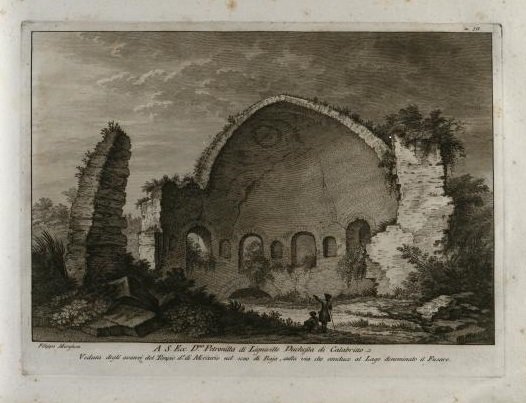
Elysian Fields
Il Mercato de Sabato does not seem to have been a market-place, where things were every Saturday exposed to sale; but rather a circus for public spectacles, exercises, &c.
Dead Sea/Mare MortuumDead Sea [info]
The Mare Mortuum, or Dead Sea, has a communication with the sea by a small canal, in which are several wire nets, &c. to prevent the fish, with which it abounds, from returning to the sea. This lake belongs to a private person, who farms it for five or six hundred scudi a year.
Miseno MisenoMiseno [info]
On the other side of the Mare Mortuum, towards the left-hand, lies the promontory of Miseno, where is still to be seen the remains of an ancient pharos, or light-house. The isthmus at the extremity near the cape is about two hundred paces in breadth from sea to sea; but farther up, towards the Dead-Sea, it is scarce fifty. Miseno is said to derive its name from a companion of Æneas, who was buried there according to Virgil...[37]
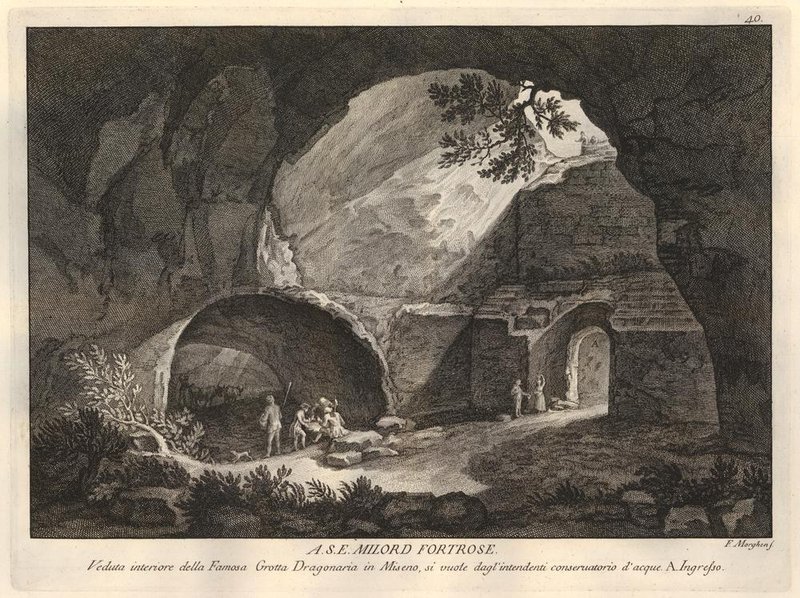
Miseno, Grotta Dragonaria
This promontory is almost entirely undermined, and the Grotta Traconaria, vulgarly called Dragonara, under it, is very well worth observing. It is divided by twelve large pilasters into five walks, or isles. The middle is the broadest, and (besides the entrance, which is sixty-eight feet) is a hundred and seventy-eight feet long; the rest being only a hundred and seventy. The four passages which cut these walks at right angles are of unequal length, from a hundred and eighty to two hundred and twenty-four feet. The breadth of the walks is about four feet, and the walls are of freestone. The use of such a building is not known with any certainty; but it is most probable that it served for a reservoir of fresh water; which was here the most necessary, part of the Roman fleet being stationed at Miseno...
Return from Miseno towards Naples
Piscina Mirabilis - Julius Caesar's palace - Tritoli - Lago d'Averno - Lago di Lucrina
Piscina Mirabilis - Cento Camerelle
Piscina Mirabilis [info] - Cento Camerelle
On this side of the Mare Mortuum in returning from Miseno is the Piscina Mirabilis, to which one descends by forty steps, part of which are at present in a ruinous condition. It is a square vault supported by forty-eight pillars; its length is two hundred and fifty palmi, the breadth a hundred and sixty, and its height near forty. The pillars are disposed in four rows, making five walks or isles. This unquestionably was a reservoir; and the square apertures in the roof, of which there are thirteen, were made for drawing out the water. The pavement is made sloping towards the center, that the sediment of the water, gathering there, might be the more conveniently removed when it was empty...
It is much disputed by whom the Piscina Mirabilis, or wonderful reservoir, was built. Some attribute it to Lucullus, who had a superb palace in the neighbourhood: others are of the opinion, that Agrippa had it made for the conveniency of the Miseno fleet, or for watering the gardens; and the chambers near it called Cento Camerelle seem to have been designed for the same purpose. As for the opinion of their being prisons for the Christians under sentence of death in Nero’s time, it has not the least probability on its side. This work which very much resembles the labyrinths, as they are called, at Puzzuolo, is lofty and in pretty good condition; the galleries are long and narrow, and several of the door are broken down...[38]
Baths of Tritoli (Baths of Nero)Baths of Tritoli (Baths of Nero)
In returning from the remains of Julius Caesar’s palace, you pass through an arched way hewn through the rocks like a long cavern, at the end of which are the celebrated warm baths, or rather, as they are indeed commonly called, I Sudatorii, or sudatories of Tritoli. They have two entrances, but afterwards are divided into six long apartments, where the heat is scarce supportable, till custom has inured one to it. A stranger should not go in without a guide and some flambeaux, as one may without such precaution fall into dangerous holes. In some parts of these sudatories are warm springs, one of which, at the end of a long passage of a hundred and twenty paces, is so hot, that a man can scarce bear a finger in the water of it, even after it has been carried out of the mouth of the cavern. Three times a year the hospital of the Annunciata sends hither whole caravans of patients, and the women have separate sudatories assigned them. This operation generally lasts seven days, and is begun about the 20th of June... On the road which has been pierced through the rocks, and before the entrance into these sudatories, are six apartments, all hewn out of the rock; which also serve for sudatories, as the heat issuing from the passages above-mentioned can be communicated to them. Formerly on the walls of these apartments were seen paintings and inscriptions expressing the distempers for which every apartment was best adapted; but nothing of these is now to be seen. This, as it is said, is owing to the envy and avarice of the Salerno physicians; the wonderful cures of these baths being a detriment to their profession. The present physicians of Naples are so far from looking on the Tritoli sudatories with an evil eye, that they not only prescribe the use of them, but have published a great number of inscriptions and Latin verses, with directions for the right application of most of the baths and sudatories in Naples...
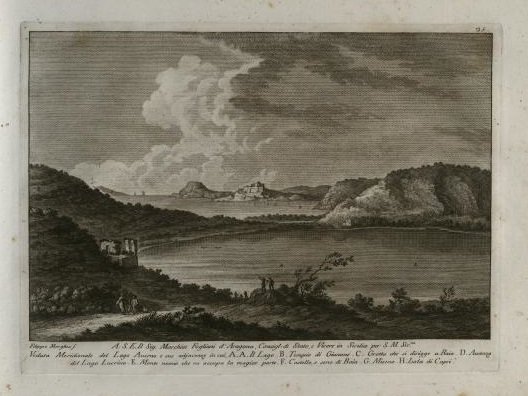
Baths at Tritoli
Lago d'AvernoLago d'Averno
From Tritoli it is proper to return to the Lago Averno, to take a view of some antiquities on this side, and likewise of the entrance into the sibyl’s cave. From this entrance to the other near Cuma, as already described, which is four Italian miles, there is said to have been in ancient times a lofty passage, which, according to Strabo, was discovered in Augustus’s time. But time and earthquakes have caused such alterations here, that, to get to the entrance of the grotto, one is obliged to crawl ten or twelve paces along the ground; and to leave a servant without, in order to fetch proper assistance, in case, as it has sometimes happened, the entrance of the cave should be filled up by the falling in of the earth and stones. Within the grotto there is a large arched passage hewn out of rock, near four hundred paces in length; you then descend on the right into another passage where the heat is great, and overflowed with warm water; so that without boots there is no proceeding any further. Beyond this there is an apartment, in which is a kind of stone trough, by some antiquarians supposed to be the sibyl’s bath, and by others her bed; on the walls are several figures made of small stones and shells of different colours curiously arranged. The pavement is also a mosaic work, but cannot be seen distinctly, as it is covered with water. Whether this cave was made for warm baths, or to provide stones for the great number of palaces which anciently stood in its neighbourhood; or whether it was designed for a refreshing cool retreat, or for some other more important use, probably, will never be ascertained. The pagan priests finding such a place ready finished to their hands, it was no difficult matter for them to turn it to their advantage in their impostures and pretended oracles: but that such a spacious and expensive subterraneous structure was no more than the mansion of sibyl is the more incredible, as all the stories of the ancients about sibyls, upon examination, are found to be entirely fabulous...
Lago di Lucrino - Monte di ChristoLago di Lucrino [info] - Monte di Christo
On the side of the Lucrine lake towards the sea is a hill with a deep rent on its summit; and the poor illiterate people are taught to believe that it was made at our Saviour’s crucifixion, and was the passage through which he descended into the Limbus Patrum, in order to release the patriarchs; and to this the mountain owes the name of il Monte di Christo.
All these curiosities, exclusive of the islands, take up a compass of thirty-five or forty Italian miles; which shews that a very superficial view of them can hardly be taken in one day, though some travelers pretend to have done it. The narrow stony roads in these parts are scarce practicable for carriages, and therefore a saddle-horse is best for this excursion, which may be hired for six carlini a day.
[1] Letter of 16 June 1770.
[2] Approximately 910 metres. By comparison, the Neutor/Siegmundstor is only 135 metres.
[3] Third edition: London, 1760, iii.108-155
[4] See Giuseppe Caridi, I Ruffo di Calabria: secoli XIII-XIX (Falzea, 1999)
[5] Virgil: 70 BC-19 BC. Virgil's tomb, a Roman burial vault said to be the tomb of the poet Virgil (October 15, 70 BC – September 21, 19 BC), is located at the entrance to a Roman tunnel known as the grotta vecchia or cripta napoletana that was built during the reign of Augustus (63 BC-19 August 14 AD, emperor from 27 BC) connecting Naples and Pozzuoli.
[6] Alfonso Herrera, O.S.A. (?-1602), Bishop of Gallipoli from 30 July 1576 and Bishop of Ariano from 25 February 1585. He died on 20 December 1602. http://www.catholic-hierarchy.org/bishop/bherra.html.
[7] Pedro Álvarez de Toledo y Zúñiga, Marquis of Villafranca del Bierzo (Salamanca, July 13, 1484–Florence, February 21, 1553), Viceroy of Naples 1532–1552. During his time as Viceroy, Toledo expanded the city walls and naval shipyards, modernized the fortresses along the coast and built the vice-regal palace, no longer extant but formerly on the site of the present-day Royal Palace, constructged in 1600. See C. J. Hernando, Castilla y Napoles en el siglo XVI. El virrey Pedro de Toledo: Linaje, estado y cultura (1532-53) (Salamanca, 1994) and Spain in Italy: Politics, Society and Religion, 1500-1700, ed. by Th. Dandelet and J. Marino (Leiden, 2006).
[8] The Italian mile, thought to derive from the Roman mile, was about 1000 paces, where a pace represents the distance covered by two steps, one with each foot; accordingly, an Italian mile – though it differed from region to region – was approximately 1800 meters. The English statute mile, established by the Weights and Measures Act of 1593, was similar, at about 1609 meters. The German mile, by contrast, was usually between 7000 and 8000 meters, depending on local conventions.
[9] Alfonso I (1073-8 September 1134), King of Aragon and Pamplona from 1104.
[10] A freshwater fish of the minnow family.
[11] Saint Germanus I (c634–733 or 740), patriarch of Constantinople 715-730.
[12] Also known as the Baths of Nero (Thermae Neronis) or the Baths of Alexander (Thermae Alexandrinae), constructed by Nero in 62AD on the Campus Martius in Rome and rebuilt by Alexander Severus in 227 or 229.
[13] The carlino, also known as the gigliato, was a silver coin weighing 4 grams; it was first put into circulation during the reign of Carlo I d’Anju (1227–7 January 1285), Count of Provence from 1246 and King of Sicily from 1266. See Philip Grierson and Lucia Travaini, Medieval European Coinage, xiv: South Italy, Sicily, Sardinia (Cambridge, 2009), 219-220.
[14] About 900 meters; see fn 8.
[15] Alfonso V (‘the Magnanimous’, 1396-27 June 1458), King of Aragon from 2 April 1416-27 June 1458 and Frederick III (‘the Peaceful’ or ‘the Fat’, 21 September 1415-19 August 1493), King of the Romans from 21 September 1415-19 August 1493 and Holy Roman Emperor from 19 March 1452-19 August 1493. Frederick married the Infanta Eleanor (18 September 1434-3 September 1767), a daughter of Duarte (‘the Philosopher’ or ‘the Eloquent’, 31 October 1391-9 September 1438), King of Portugal and the Algarve from 14 August 1433-9 September 1438, at Rome on 19 March 1452.
[16] Verde antico, also known as ophite, is a kind of rock, usually green in colour with white veins, that takes a high polish and is popular as a decorative facing stone. Lapus lazuli is a blue metamorphic rock used for jewelry and, when crushed, as the basis for blue pigments.
[17] An igneous rock found in volcanic areas.
[18] The notion of a ponte di Caligula derives from the De Vita Caesarum of the Roman historian Suetonius (Gaius Suetonius Tranquillus, c69 AD-after 122 AD): ‘Nouum praeterea atque spectaculi excogitavit. Nam Baiarum medium interuallum [ad] Puteolanas moles, trium milium et sescentorum fere passuum spatium, bridge conunxit contractis undique onerariis nauibus et dual order ad anc [h] oras conlocatis superiectoque terrain ac derecto in Appiae uiae formam. For hunc pontem ultro citro commeauit biduo continents, first die phalerato equo insignisque quercea corona et caetra et gladio aureaque chlamyde, postridie quadrigario habitu curriculoque biiugi famosorum equorum, prae se ferens Dareum puerum ex Parthorum obsidibus, comitus praetorianorum agmine et in essedis cohorte amicorum. Scio plerosque existimasse talem to Gaius pontem excogitatum aemulatione Xerxis, qui non sine admiratione aliquanto angustiorem Hellespontum contabulauerit; alios, ut Germaniam et Britanniam, quibus imminebat, alicuius inmensi operis fame territaret.’ (He also devised a kind of absolutely new and unprecedented show. He built between Baia and the Pozzuoli dam, which separated a space of about three thousand and six hundred paces, a bridge formed by cargo ships, gathered on all sides and placed at anchor in two rows; then it was covered with earth giving the whole appearance of the Appian Way. For two days in a row he did not stop coming and going on this bridge: on the first day he showed up on a richly harnessed horse, with an oak crown, a harp, a sword and a golden brocade garment, the day after dressed as a coachman of quadriga, he drove a chariot pulled by two famous horses, which were preceded by the young Darius, one of the Parthian hostages, and followed by a host of Praetorians and vehicles carrying a group of friends.)
[19] A seahorse, hence testaceous, meaning a fish with a hard shell.
[20] The medicinal use of seahorses derives from traditional Chinese practices; they have been considered effective in the treatment of asthma, infections of the throat, insomnia, abdominal pain, and skin infections and sores. See K. Kumaravel, S. Ravichandran, T. Balasurbramanian and L. Sonneschein, ‘Seahorses: A Source of Traditional Medicine’, Natural Product Research 26/25 (2012), 2330-2334.
[21] Presumably the ‘temple at Puzzuolo’ is a misprint for ‘temple at Rome’. Hadrian (reigned from 10 August 117) died on 10 July 138 in his villa at Baia; first buried on an estate in Pozzuoli that had once belonged to Cicero, his remains were transferred shortly afterwards to Rome and, in 139, to the newly-completed Mole Adrianorum, now the Castel Sant’Angelo.
[22] Convento Calmadoli.
[23] In fact, the eruption began on 29 September 1538, building the cone of Monte Nuovo over the course of a week. See Mauro Di Vito, Lucio Lier, Giuseppe Mastrolorenzo and Giuseppe Rolandi, ‘The 1538 Monte Nuovo eruption (Campi Flegrei, Italy)’, Bulletin of Volcanology 49/4 (1987), 608-615.
[24] The name Avernus derives from the Greek άορνος, that is, ‘without birds’; according to both the Greeks and the Romans, Lago Averno was also one of the entrances to Hades. Further, see Yulia Ustinova, Caves and the Ancient Greek Mind: Descending Underground in the Search for Ultimate Truth (Oxford, 2009), 76-81.
[25] The bust of the Gigante di Palazzo is now in the garden of the Museo Nazionale di Napoli. Further, see Flavia Coraggio, Il Tempio della Masseria del Gigante a Cuma (Bologna, 2013).
[26] Now the Università degli Studi di Napoli Federico II. Founded by Federico II in 1224, the university was . . . Patrizia: Since Keyssler says it was unfinished, I presume there were renovations going on at this time, as in much of Naples. What I’m trying to figure out is when these renovations were completed and by whom – it may be that they were by the time the Mozarts were there since Keyssler was first written several decades earlier. I’ve been unable to find this out easily.
[27] Founded in the 8th century BC, Cumae was the first Greek colony on mainland Italy; it was destroyed in 1207 by Neapolitan forces acting on behalf of Federico I. The ruins of the city are southeast of the modern village of Cuma in the commune Bacoli.
[28] Priestess of the oracle of Apollo at Cumæ and intermediary between Hades (with its entrance at Lago Averno, see above) and the living world. She figures prominently in Virgil’s Aeneid VI, and in Ovid’s Metamorphoses 14 as Aeneas’s guide to the shade of his father, Anchises; Ovid also recounts the story of her supposed longevity, 1000 years: ‘“I am no goddess,” she replied, “nor is it well to honor any mortal head with tribute of the holy frankincense. And, that you may not err through ignorance, I tell you life eternal without end was offered to me, if I would but yield virginity to Phoebus for his love. And, while he hoped for this and in desire offered to bribe me for my virtue, first with gifts, he said, ‘Maiden of Cumae choose whatever you may wish, and you shall gain all that you wish.’ I pointed to a heap of dust collected there, and foolishly replied, `As many birthdays must be given to me as there are particles of sand.' For I forgot to wish them days of changeless youth. He gave long life and offered youth besides, if I would grant his wish. This I refused, I live unwedded still. My happier time has fled away, now comes with tottering step infirm old age, which I shall long endure. You find me ending seven long centuries, and there remain for me, before my years equal the number of those grains of sand, three hundred harvests, three hundred vintages!’
[29] Wezel remains unidentified although he is mentioned in several contemporaneous military histories. See, for example, John Campbell, The Military History of the Late Prince Eugene of Savoy (London, 1737), ii.271-272 and 319; and Joannes Rudolphus Conlin, Carolus VI. Dei gratia gloriosus in orbe imperator. Oder Glorreichiste Regierung und unvergleichliche Thatten Caroli VI (Augsburg, 1721), 120, 126, 232, 335-336 and 585.
[30] Presumably the baths at the Villa dei Pairi (or Villa dei Pisoni), at one time owned by Lucius Calpurnius Piso Caesoninus (c100 BC–43 BC), Roman senator and father-in-law of Julius Caesar.
[31] Dating from the later Roman Republic (to 27 BC), the so-called Temple of Mercury is one of several surviving Roman baths in Baia, together with the temples of Venus and Diana.
[32] Three rooms in the Roman Imperial palace at Baia; for a detailed description, see Roger Ling, ‘II. The Stanze di Venere at Baia’, Archaeologia 106 (1979), 33-60.
[33] Antonio Giudice, Prince de Cellamare (1657-1733), Spanish ambassador to France. He is best known for his participation in a conspiracy to substitute Philip V of Spain as Regent of France – following the death of Louis XIV – instead of Philippe II, Duc d’Orléans.This episode was the basis for Alexandre Dumas père ’s novel Le chevalier d’Harmental (1843).
[34] Baiae was a fashionable resort town during the late Roman Republic but was abandoned by about 1500. Some ruins –mostly submerged due to earlier volcanic activity in the area – are now part of the Parco Archeologica delle Terme di Baia. In general, see Amadeo Maiuri, The Phlegraean Fields from Virgil’s Tomb to the Grotto of the Cumaean Sibyl (Rome, 1947).
[35] Quintus Hortensius Hortalus (114 BC-50 BC), Roman aristocrat, orator, and in 69 BC co-consul with Quintus Caecilius Metellus Creticus (c135 BC-late 50s BC). Ruins at Bauli, on the coast near Baieae, are thought to be Hortensius’s villa.
[36] Caesar’s villa no longer survives; it was probably located on the site of the present-day castello Aragonese.
[37] See Virgil, Aeneid (vi.162-175): ‘And as they [Aeneas and Achates] passed along / they saw Misenus, ruined by shameful death, on the dry sand, / Misenus, son of Aeolus, than whom none was more outstanding / in rousing men with the war-trumpet, kindling conflict with music. / He was great Hector’s friend: with Hector / he went to battle, distinguished by his spear and trumpet. / When victorious Achilles despoiled Hector of life, / this most courageous hero joined the company / of Trojan Aeneas, serving no lesser a man. But when, / by chance, he foolishly made the ocean sound / to a hollow conch-shell, and called gods to compete / in playing, if the tale can be believed, Triton overheard him / and drowned him in the foaming waves among the rocks.’
[38] See Ceasare Rossi and Flavio Russo, Ancient Engineers’ Inventions: Precursors of the Present (New York, 2009), 124-125.